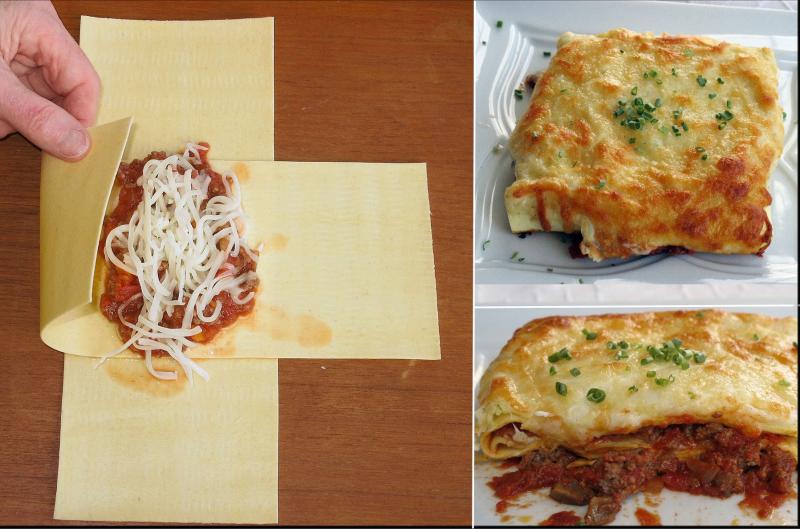Lasagna packets are easy to assemble
A few weeks ago, I watched a video of someone making lasagna by tucking ingredients into small folded packets of pasta instead of layering everything in a huge pan. Although tempted to try it, I've never been a fan of parboiling noodles and fighting with burning-hot pasta. Then, on a recent trip to Acme, I found fresh lasagna sheets in the dairy aisle. I was set.
The strips of fresh pasta were thin but sturdy and just a bit too wide, so I trimmed off about an inch down the long edge. Next time, I may try cutting them in half lengthwise to make the packets slightly smaller. Ingredients for the recipe are similar to a standard lasagna: pasta, meat sauce, mozzarella and Parmesan cheese. Where this differs is in the substitution of béchamel sauce for ricotta cheese.
For those of you unfamiliar with it, béchamel is a basic white sauce made from butter, flour and milk. It has long been considered one of the "mother sauces" in French cuisine. Food historians have floated several origin theories for this versatile sauce, ranging from Catherine de Medici's Italian-trained chefs who followed her to France, to a 17th century steward named Béchamel who tried to find a more palatable way to enjoy dried cod.
The likeliest creator was a court chef for Louis XIV named Varenne. As the author of Le Cuisinier Francois, he is considered the founder of haute cuisine. His recipe for Béchamel Sauce appeared in this cookbook, one of the first sauces to feature a flour and butter roux instead of bread as a thickener. No matter who gets the credit, this sauce is a silky addition to many dishes.
You will find some lasagna recipes made with ricotta cheese or cottage cheese whisked with an egg, while others insist on a delicate béchamel to lighten the layered dish. I've made all sorts of lasagna recipes using sauces white, red or both, as well as those with chunky cottage cheese. My preference is béchamel, for the way it helps meld flavors and melt into the pasta.
The lasagna packets (sometimes called pockets) are easy to assemble once you've simmered the meat sauce and stirred together your white sauce. As you can see from the photo, the noodles are arranged in the shape of a cross with the meat sauce and mozzarella placed in the center. What you can't see is the extra bit of béchamel spread on the bottom sheet of pasta.
Another version of the folded packets is to make individual lasagna rolls. Each piece of pasta is covered with a layer of white sauce (or a seasoned ricotta cheese mixture), a layer of tomato sauce and then rolled up lengthwise. Whether packets or rolls, you'll want to cover the exposed pasta with either white or red sauce and a sprinkle of mozzarella before baking.
I've included recipes for both versions, the packets made with béchamel and the lasagna rolls with ricotta. I've included instructions for a basic meat and tomato sauce, but you can always substitute your grandmother's secret recipe.
Meat Sauce
1 t olive oil
1 lb ground beef
1 t salt
1/2 t black pepper
1 t olive oil
1 diced onion
1 diced carrot
1/2 C diced mushroom
2 minced garlic cloves
1/2 t red pepper flakes
1/4 C Balsamic vinegar
2 T tomato paste
2 C tomato purée
Heat 1 t oil in a large skillet over medium. Add beef and cook until browned, breaking up larger chunks with a wooden spoon. Stir in salt and pepper.
When cooked, remove meat to a strainer to drain off fat. Add 1 t oil to the same skillet over medium. Add onion, carrot, mushroom and garlic; sauté until softened. Deglaze the skillet with the Balsamic vinegar, scraping up any browned bits. Add tomato paste and return cooked meat to the pan; stir to combine. Stir in red pepper flakes and tomato purée. Bring to a boil, then cover and reduce heat to low; simmer for 15 minutes.
Béchamel Sauce
2 T butter
2 T flour
1 C milk
1/4 t grated nutmeg
1/4 t white pepper
salt, to taste
Melt the butter in a small saucepan over medium. Add the flour and whisk to blend with the butter. Cook until golden, about 2 minutes, whisking constantly. Gradually add the milk while whisking to prevent lumps. Slowly bring to a boil, then reduce heat and simmer until thickened, about 10 minutes, whisking frequently. Remove from heat; stir in nutmeg, white pepper and salt, to taste.
Lasagna Packets
8 fresh lasagna noodles
2 C meat sauce
1 1/2 C béchamel sauce
1 1/2 C grated mozzarella
1/4 C grated parmesan
Preheat oven to 350 F. Line a baking sheet with aluminum foil; coat with nonstick cooking spray. Spread a thin layer of meat sauce over the foil; set aside. Place one sheet of pasta oriented horizontally on a flat work surface. Spread a thin layer of béchamel in a 2-inch square in the center. Place another lasagna noodle oriented vertically over the square of sauce. Spread a square of béchamel on this sheet and top with 1/4 C meat sauce. Sprinkle evenly with 1 T mozzarella. Fold in left side, bottom flap, top flap and then right side. Repeat with remaining pasta sheets.
Cover packets with remaining béchamel, sprinkle with mozzarella and parmesan. Bake until bubbling and lightly browned, about 25 minutes. Yield: 4 servings.
Lasagna Rolls
2 C meat sauce
1 egg
1 15-oz container ricotta cheese
3 T chopped parsley
2 1/2 C shredded mozzarella cheese
3/4 C grated Parmesan cheese
1/2 t salt
1/4 t pepper
12 fresh lasagna noodles
Preheat oven to 350 F. Coat the inside of a 9 x 13-inch baking dish with nonstick cooking spray. Spread a thin layer of sauce to cover the bottom of the pan; set aside. Whisk egg in a medium bowl. Add ricotta cheese, parsley, salt and pepper; whisk until combined.
Stir in 2 C mozzarella cheese, 1/2 C Parmesan cheese; whisk until combined. Place a lasagna sheet on a flat work surface. Spread with a layer of cheese mixture and then a layer of meat sauce. Roll up, starting with the shorter edge, and place seam side down in the prepared pan. Repeat with remaining pasta. Cover rolls with remaining meat sauce. Sprinkle with remaining 1/2 C mozzarella and 1/4 C Parmesan cheese. Loosely cover the pan with aluminum foil and bake for 30 minutes. Remove foil and cook for another 5 minutes. Yield: 6 servings.
Reader shares tips
After reading last week's column on Dutch babies, Jeanette Higgs of Lewes shared some of her tips for the dish. Instead of a bulky cast-iron skillet, she uses either a 10-inch cake pan (for a crowd) or a large cupcake tin (for individual servings). She garnishes these with sliced fresh strawberries and a sprinkle of powdered sugar.




















































